Honolulu
The name Honolulu means ‘protected bay’ and on that bay a fishing village was founded as early as the 12th century. So well protected is the bay that in 1778 Captain Cook on HMS Resolution sailed past without spotting either the bay or the fishing village. In 1794 British Captain William Brown discovered the bay and named it ‘Fair Haven’. King Kamehameha I conquered Oahu in 1804 and set up his Waikiki but moved it to Honolulu in 1809. Although Kamehameha III moved the capital to Lahaina in 1820, he returned in 1845 and Honolulu became the permanent capital of the Kingdom. The city boomed even through the times of the overthrow of the monarchy and annexation by the USA. In 1899 an outbreak of bubonic plague affected the densely populated Chinatown area and the authorities responded by burning houses where the infection had occurred. In early 1900 one of these burnings spread out of control for 17 days, destroying 15 hectares (38 acres) of the city. Honolulu recovered from this and continued to grow as the capital, centre of commerce and primary port of entry to Hawaii. So what is Honolulu like today? Think of a Polynesian island paradise and a typical ugly, high rise US city. Transplant the latter into the former and you have Honolulu.
Ali'iolani Hale (Supreme Court) & Kamahameha statue
King Kamehameha V commissioned Australian Thomas Rowe to design a new palace to replace the old ‘Iolani Palace. In 1872 the King laid the cornerstone but because the he had realised that the growing government of Hawaii was desperately short of accommodation, he re-designated it as a government office. Although it was called Ali’iolani Hale (House of Heavenly Chiefs) it was used to house the Hawaiian Legislature and Supreme Court. In 1878 a statue of King Kamehameha I was erected in front of the building to celebrate the 100th anniversary of the arrival of Captain Cook in the Hawaii. In 1887 a group led by some plantation owners forced King Kalakaua to accept a constitution that significantly reduced his powers. Two years later Robert Wilcox led 150 armed insurgents in a revolt against the changes to the constitution, aiming to depose King Kalakaua and replace him with his sister Princess (later Queen) Liliuokalani. Wilcox briefly took control of both Ali’iolani Hale and the ‘Iolani Palace but the insurgents were driven out by government forces. A jury later refused to convict Wilcox. Kamehameha V was renovated in 1911 to make it more suitable for use as offices, and in the 1940s a new wing was added which was designed to match the original building. It is still houses the Hawaii Supreme Court, but fans of the 2010 Hawaii Five-0 may recognise it as the fictional HQ of the Five-0 task force. Click Tab 2 to see a close-up of the Statue of King Kamahameha I.
‘Iolani Palace
This is the only Royal Palace in the USA. Before the American revolution the 13 colonies on the east coast of the USA had George III as their king, but he never quite got round to building a royal palace in any of them. The ‘Iolani Palace is a reminder that Hawaii was once a monarchy. It was the official residence between 1882 and 1893 of the Hawaiian Kingdom’s last two monarchs King Kalakaua and Queen Liliuokalani. When King Kalakaua ascended the throne in 1874 the old and small ‘Iolani Palace was in a poor state of repair due to termite damage. Kalakaua had travelled to Europe and seen royal palaces there, so he ordered that the old palace be demolished and work commence on a new and more grandiose one. Construction of the new palace started in 1879 and it was completed in 1882. In 1883 Kalakaua held a coronation ceremony in the grounds and the pavilion used for this was then relocated within the grounds and converted into a Royal Bandstand. When the monarchy was overthrown, the palace was used by the Provisional Government and for a time Queen Liliuokalani was imprisoned there. After the US annexed Hawaii, the ‘Iolani Palace became the headquarters of the Territorial Government and was the home of the State Goverment until 1969 when the Capitol opened. After the government moved out, the ’Iolani Palace was restored and it is now open to the public as a museum. If you have visited royal palaces in Europe, such as Buckingham Palace in London, you will notice a major difference. The European palaces have been kept largely in their original context, whereas ‘Iolani Palace is belittled by skyscrapers towering over it. Click Tab 2 to see the Royal Bandstand
Waikiki Beach & Diamond Head
The place where King Kamehameha I first set up his court on Oahu is now best known for its high rise hotels and sandy beach. The beach is normally teeming with people. This picture was taken from in front of the Moana Surfrider Hotel, an historic hotel that was the first hotel on Waikiki Beach opening as the Moana Hotel in March 1901. Click Tab 2 to see the Mona Surfrider Hotel.
Washington Place
In 1841 Hawaii was ruled by King Kamehameha III but American influence was growing. American traders and plantation owners were becoming increasingly influential. One such trader was Captain John Dominis who in 1841 decided to build his residence on the outskirts of the village of Honolulu. The Greek-Revival mansion was designed and built by Isaac Hart who was also responsible for the first ‘Iolani Palace. The mansion was nearing completion in 1846 when Captain Dominis’ ship disappeared on a mission to China to buy furniture for the house. His widow was forced to rent out part of the mansion to make ends meet. In 1848 US Commissioner Anthony Ten Eyck lodged in the mansion giving it the name Washington Place, which met with approval from King Kamehameha III who backed it up with a royal decree. Captain Dominis’ son John married Princess Liliuokalani in 1862, and Washington Place became her home. As Queen Liliuokalani she was arrested in the mansion in 1893 during the overthrow of the monarchy. In 1985 she was imprisoned in ‘Iolani Palace for a year but then returned to Washington Place where she lived until her death in 1917. After her death the house became the Executive mansion for Territorial and later State Governors. In 2001 a new Governor’s Mansion was built in the grounds so Washington Place was restored as a house museum. Tours are run once a week and must be reserved at least 48 hours in advance.
DLU160729
Click on Minimap to navigate
Hawaiian Mission Houses Historic Site
Sugar Planters had an enormous influence on Hawaii, but Missionaries also played a major role. The Hawaiian Mission House Historic Site has preserved three buildings that were homes and workplaces for the early Christian Missionaries and in those buildings it tells their story. On the left of the picture is the 1821 Mission House, the oldest house in its original location in Hawaii. It was a communal home for the missionary families and also provided lodgings for visitors. Chamberlain House on the right was used as a store house and dates from 1831. The small building in the middle is the Print Office dating from 1841. Hawaiian Mission Houses Historic Site is open to the public for guided tours Tuesday to Saturday.
'Iolani Barracks
In addition to Ali’iolani Hale, King Kamehameha V was responsible for this building. ‘Iolani Barracks were built in 1870-71 in what became Hotel Street. They were designed by the architect Theodore Heuck in the style of a medieval European castle. The barracks were used to house the 80-strong Royal Guard and contained a kitchen, mess hall, dispensary, living quarters and prison cells. After the overthrow of the monarchy in 1893 they were used for several different purposes at different times: headquarters of the National Guard of Hawaii, temporary accommodation for refugees from the 1899 Chinatown fire, a government office building, and for storage. Where the barracks originally stood is now the site of the State Capitol. In 1965 it was dismantled block by block and rebuilt on its current site adjacent to the ‘Iolani Palace and it now houses the Visitor Center for the palace.


To move forwards or backwards through the Oahu Trail click the arrows above, or select your next destination on the Minimap.
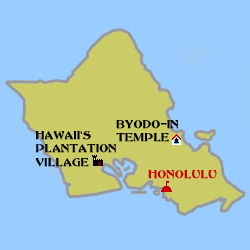

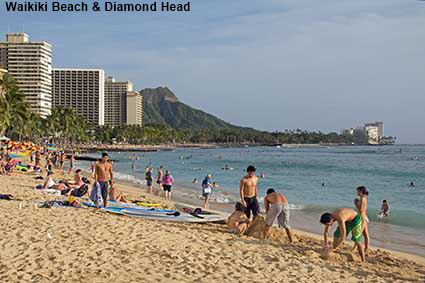
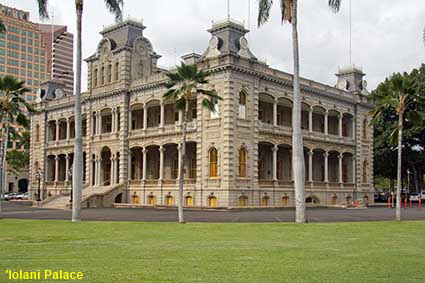
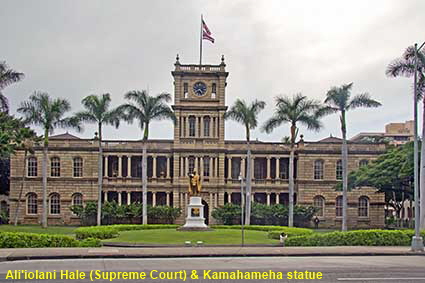
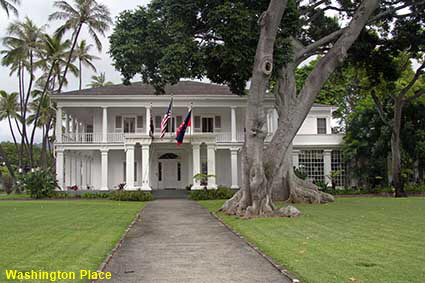
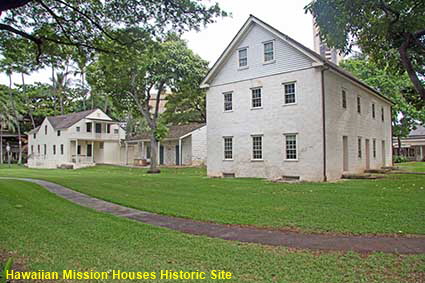
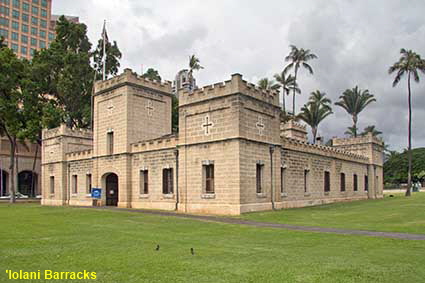
© Mike Elsden 1981 - 2025
The contents of this page may not be reproduced in full or in part without permission